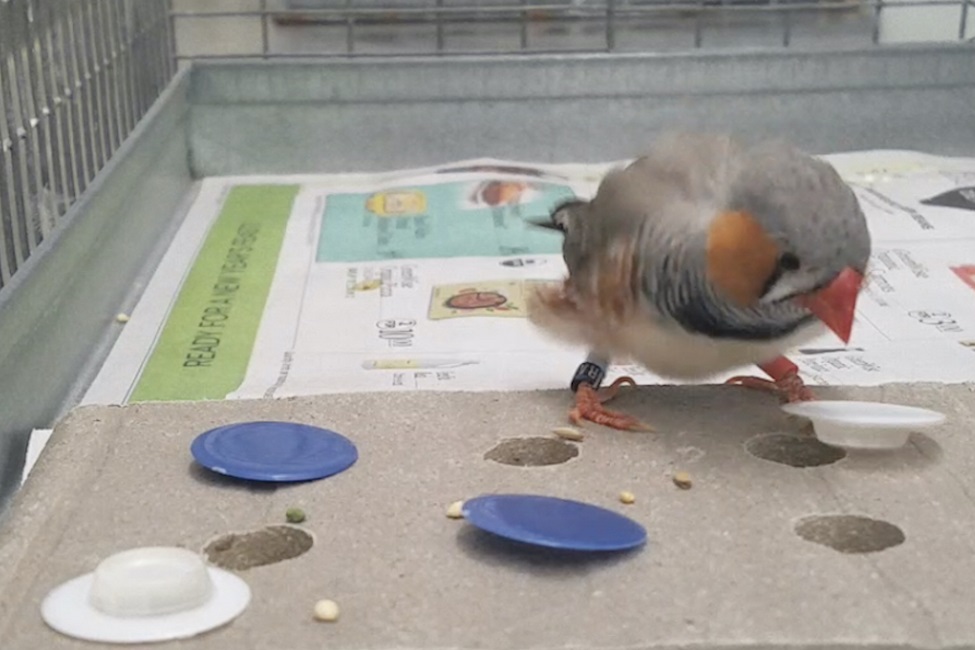Study First to Show Relationship between a Bird’s Gut and its Brain

A male zebra finch, learning to flip lids in search of food rewards, is midway through solving the final stage of the novel foraging task. (Photo credit: Morgan C. Slevin)
Despite extensive support for relationships between the gut microbiome and the brain (the “microbiota-gut-brain axis”) in humans and rodents, little is known about these relationships in other animals, leaving questions about this system’s generality.
To address these knowledge gaps, researchers from Florida Atlantic University’s Charles E. Schmidt College of Science, FAU Broward Campuses and FAU's Harbor Branch Oceanographic Institute, in collaboration with Cornell University, studied the relationship between cognition and the gut microbiome of captive zebra finches (Taeniopygia guttata). Songbirds provide an opportunity to test for a microbiota-gut-brain axis because of recent advances in understanding avian cognition.
In a population of 38 zebra finches, researchers quantified performance on cognitive tasks measuring learning and memory. For the study, they sampled the gut microbiome using a cloacal swab and quantified bacterial alpha and beta diversity. The zebra finch cloacal microbiome is representative of that of its large intestine.
Results of the study, published in the Royal Society’s journal Biology Letters , showed that captive zebra finches’ gut microbiome characteristics were related to performance on a cognitive assay where they learned a novel foraging technique. Researchers also identified potentially critical bacteria that were relatively more abundant in birds that performed better on this assay. This correlation provides some of the first evidence of a relationship between a bird's gut microbiome and its brain.
“An animal’s gut microbiome can have wide-ranging effects on health, cognitive performance and behavior, coining the conceptual framework ‘microbiota-gut-brain axis,’” said Morgan C. Slevin, lead and corresponding author and an FAU Ph.D. student in integrative biology and neuroscience. “The gut microbiome can affect the brain directly by releasing neurotransmitters and precursors that stimulate the vagus nerve and indirectly by influencing the immune system. Gut microbiome characteristics have been linked in rodents and humans to learning and memory and mental health.”
To assess cognitive performance, the researchers tested the zebra finches using three tasks measuring learning and memory: novel foraging, color association, and color reversal. Each bird was tested individually (visually but not acoustically isolated from other subjects) and researchers viewed and scored trials remotely via video.
Findings showed Helicobacter, responsible for many intestinal diseases including ulcers, and Gallibacterium, with many hemolytic species found in birds including poultry, were generally more abundant in birds that performed poorly.
“While we did not identify beneficial taxa responsible for differences among performance categories, we suggest Helicobacter and Gallibacterium may signal microbiome imbalance or maladaptation in poor-performance birds,” said Rindy C. Anderson, Ph.D., senior author, an assistant professor of biological sciences in FAU’s Charles E. Schmidt College of Science, and a member of FAU’s Brain Institute. “This finding raises the question: ‘Do specific taxa influence cognitive performance? Or, is a songbird’s gut microbiome simply indicative of host quality and thus correlated with cognitive ability?’ Research could address these questions by describing the functionality of the core microbiome members for more bird species and testing how specific pre- and probiotic treatments affect cognitive ability.”
The researchers note that another intriguing possibility is that microbiome characteristics impact some cognitive processes more than others depending on sex, such as motor learning and short-term memory (novel foraging) compared to longer-term associative memory (color association) and flexibility (color reversal).
These studies will be crucial to understanding how the microbiome affects the brain and overall health of wild and captive animals.
Study co-authors are Jennifer L. Houtz, a Ph.D. student in the Department of Ecology and Evolutional Biology, Cornell University; and David J. Bradshaw, II, Ph.D., a post-doctoral fellow geneticist, FAU’s Harbor Branch.
This work was supported by FAU’s Department of Biological Sciences Scholarship, FAU’s Office of Undergraduate Research and Inquiry (OURI) Award, OURI’s SURF program, an American Ornithological Society Hesse Award, the National Science Foundation’s LEARN program (funded by NSF’s IUSE program, grant #1524601, 1524666 and 1524607), RCA’s startup fund, a Defense Advanced Research Projects Agency award (#D17AP00033 to Maren Vitousek, Ph.D.), and a Sigma Xi GIAR Award.
-FAU-
Tags: students | faculty and staff | jupiter | science | harbor branch | research